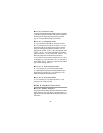
39
In each cellular service area there are usually two cellular
operators operating public systems of type “A” or “B”.
One of the public systems (A or B) is your home system
(depending on your operator) but your phone can work
with both types of systems. With Menu 7, you can select
the type of system the phone should use.
(If you have registered with several operators, use Menu 8,
NAM SELECT
, to select a NAM. This determines which
phone number and “home system” the phone uses.)
Both A&B
means that when roaming, the phone first tries
to use a home-type system (such as “B” if the home sys-
tem is B). If this is not available, it then tries to use a non-
home type system (such as “A” if the home system is B).
Hometype A or Hometype B
means the phone tries
to use only a home-type system.
Non-Home A
or
Non-Home B
means the phone tries to
use only a non-home-type system.
Home Area
means the phone cannot roam at all.
Note: To use this option, your home system operator must
have a roaming agreement with the host company whose
system you try to use. Contact your home system operator
for the roaming agreements they have with other operators.
Depending on the selection either the A or B indicator
(or both) will appear. Neither indicator appears if Home
Area is selected.
Roaming Indicators in Public Systems
When the phone begins roaming, it beeps, displays
ROAMING
, and lights the roaming indicator ( ). For a
description of the two states of the roaming indicator, see
“Keys and the Display”, page ii. Some cellular systems can
recognize a roaming phone automatically. In other
systems, you must contact the cellular operator before the
system can recognize the phone. You will need to give
your phone number, your phone’s ESN (electronic serial
number), and how you plan to pay for your calls. There is
usually an additional charge for roaming calls.


















